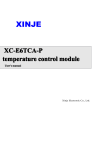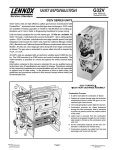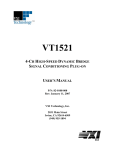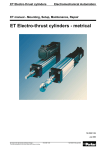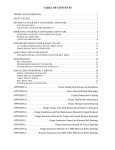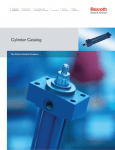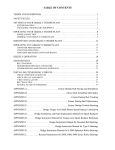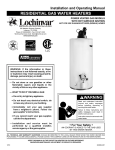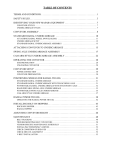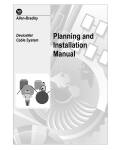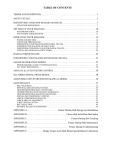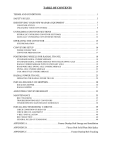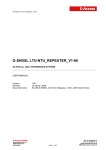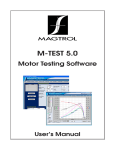Download English - Magtrol
Transcript
Model TMF 401–403 Torque Flange Transducer User’s Manual While every precaution has been exercised in the compilation of this document to ensure the accuracy of its contents, Magtrol, Inc. assumes no responsibility for errors or omissions. Additionally, no liability is assumed for any damages that may result from the use of the information contained within this publication. COPYRIGHT Copyright ©2003 Magtrol, Inc. All rights reserved. Copying or reproduction of all or any part of the contents of this manual without the express permission of Magtrol is strictly prohibited. First Edition – August 2003 Safety Precautions OPERATOR’S DUE CARE OBLIGATIONS The TMF 400 Series The Torque Measuring Flange was designed and built under consideration of a hazard analysis and upon careful selection of the harmonized standards as well as of other technical specifications to be adhered to. Thus, the system meets the state-of-the-art requirements and guarantees the highest safety standards. But such safety can in practice be reached only, if all the necessary measures will have been taken. It is the machine operator’s obligation of due care, to plan such measures and to control their execution. Above all, the operator must assure, that: • The system is used in accordance with the provisions as intended only (see Section 1.1) • The system is operated under perfect and well-functioning conditions and that specifically the safety equipment is checked regularly for its functional integrity • The required personal protective equipment for the operation, maintenance, and repair personnel is available and is in fact being used • The Operating Manual is always in a readable condition, and completely available at the service location of the measuring equipment. In addition to the Operating Manual, further operating instructions must be made available regarding occupational legislation and legal provisions on the use of technical work aids. • Sufficiently qualified and authorized personnel only is executing the operation, service and repair of the machine • Such personnel is trained regularly regarding all applicable questions of occupational safety and environ-mental protection, and that such personnel is aware of the provisions of the Operating Manual, specifically the safety instructions included • All safety and warning instructions attached on the machine must not be removed and shall remain in a readable condition SYSTEM MODIFICATIONS For reasons of safety, no unauthorized modifications must be conducted on the measuring equipment. Any intended modifications, mechanical or electrical must be authorized in writing by the corresponding department of Magtrol. The given warranty expires before its regular term, if the ordering party or any third party conducts unauthorized modifications or repairs on the delivered systems, without the prior written approval from Magtrol. Please use original spare parts only, because they were specifically designed for this system. STOP SPECIAL TYPES OF HAZARDS If the system is operated without shaft protection device and with the top cover in the open position, there will be the hazard of particles being thrown out after having fallen inside, or of such particles being jammed between stator and rotor. The consequences resulting thereof may, in extreme cases, lead to a destruction of the shaft system or to considerable personal injuries. i Revisions To This Manual The contents of this manual are subject to change without prior notice. Should revisions be necessary, updates to all Magtrol User’s Manuals can be found at Magtrol’s web site at www.magtrol.com/support/manuals.htm. Please compare the date of this manual with the revision date on the web site, then refer to the manual’s Table of Revisions for any changes/updates that have been made since this edition. REVISION DATE First Edition – August 2003 TABLE OF REVISIONS First Edition – no revisions made to date. ii Table of Contents SAFETY PRECAUTIONS ......................................................................................................................... i OPERATOR’S DUE CARE OBLIGATIONS ........................................................................................................................ i SYSTEM MODIFICATIONS ................................................................................................................................................ i SPECIAL TYPES OF HAZARDS ......................................................................................................................................... i REVISIONS TO THIS MANUAL ............................................................................................................... ii REVISION DATE .................................................................................................................................................................ii TABLE OF REVISIONS ......................................................................................................................................................ii TABLE OF CONTENTS ......................................................................................................................... iii PREFACE ................................................................................................................................................ v PURPOSE OF THIS MANUAL ........................................................................................................................................... v WHO SHOULD USE THIS MANUAL ................................................................................................................................ v MANUAL ORGANIZATION ............................................................................................................................................... v CONVENTIONS USED IN THIS MANUAL ..................................................................................................................... vi 1. INTRODUCTION ................................................................................................................................ 1 1.1 INTENDED USE ........................................................................................................................................................... 1 1.2 COMPOSITION ............................................................................................................................................................ 2 1.3 FUNCTIONAL DESCRIPTION ................................................................................................................................... 3 1.3.1 Temperature Compensation ............................................................................................................................. 4 1.3.2 Optional Measuring Range .............................................................................................................................. 5 1.4 DATA SHEET ................................................................................................................................................................ 6 2. INSTALLATION/CONFIGURATION ................................................................................................. 10 2.1 INSTALLATION SAFETY ......................................................................................................................................... 10 2.1 MECHANICAL INSTALLATION OF MEASURING FLANGE AND STATOR ..................................................... 11 2.1.1 Suspended Installation ................................................................................................................................... 11 2.1.2 Front-Mounting of Stator and Flange Close to a Bearing ............................................................................. 12 2.1.3 Base-Mounted Stator Directly at the Machine Power Take-Off .................................................................... 12 2.2 TMF WITH SIGNAL BOX .......................................................................................................................................... 14 2.3 MECHANICAL INSTALLATION STEP BY STEP ................................................................................................... 14 2.3.1 Installtion Dimensions ................................................................................................................................... 15 2.4 ELECTRIC CONNECTIONS ...................................................................................................................................... 16 3. SIGNAL BOX .................................................................................................................................... 17 3.1 INTRODUCTION ........................................................................................................................................................ 17 3.1.1 Features .......................................................................................................................................................... 17 3.2 INSTALLATION ......................................................................................................................................................... 18 3.2.1 Component Control ....................................................................................................................................... 18 3.2.2 Component Connection ................................................................................................................................. 18 3.3 CONFIGURATION ..................................................................................................................................................... 19 3.3.1 External Power Supply .................................................................................................................................. 19 3.3.2 Grounding ...................................................................................................................................................... 19 3.3.3 Accident Prevention ....................................................................................................................................... 19 3.3.4 Pin Assignment .............................................................................................................................................. 20 3.3.5 Connecting the RS422 I/O (optional) ............................................................................................................ 21 3.3.6 Connecting the TCU1 with a PC ................................................................................................................... 21 iii Table of Contents Magtrol TMF Torque Flange Transducer 3.4 SETTINGS ................................................................................................................................................................... 22 3.4.1 Operating Principle ........................................................................................................................................ 22 MAGTROL LIMITED WARRANTY ........................................................................................................ 23 TABLE OF FIGURES CHAPTER 1 Figure 1–1 Figure 1–2 Figure 1–3 Figure 1–4 Torque Measuring System Configuration ............................................................................................... 2 Composition of Measuring Flange ......................................................................................................... 3 Basic Structure of Temperature Compensation ...................................................................................... 4 Basic Structure of the Second Torque Measuring Range ....................................................................... 5 Figure 2–1 Figure 2–2 Figure 2–3 Figure 2–4 Figure 2–5 Figure 2–6 Figure 2–7 Figure 2–8 Suspended Installation ......................................................................................................................... 11 Front Mounted Installation .................................................................................................................. 12 Base (or Foot) Mounted Installation .................................................................................................... 12 Torsion-resistant Shaft Clutch Element, Type 920 ............................................................................... 13 Removal of Cover ................................................................................................................................. 14 Flange Plate ......................................................................................................................................... 14 Insertion of Measuring Shaft ................................................................................................................ 15 Connecting TMF Measuring Flange with Signal Box ......................................................................... 16 Figure 3–1 Figure 3–2 Figure 3–3 TCU1-SB1 Signal Box .......................................................................................................................... 17 RS422 Output Signal Connection ........................................................................................................ 21 Operation Flowchart ............................................................................................................................ 22 CHAPTER 2 CHAPTER 3 iv Preface PURPOSE OF THIS MANUAL This manual contains all the information required for the setup TMF 400 Series Torque Flange Transducers. To achieve maximum capability and ensure proper use of the transducers, please read this manual in its entirety before operating. Keep the manual in a safe place for quick reference whenever a question should arise. WHO SHOULD USE THIS MANUAL This User’s Manual was compiled for those individuals concerned with the planning, assembly and the taking into service of torque measurement equipment and systems with torque measuring shafts. General knowledge of mechanical and electrical engineering is required as a prerequisite for the installation and the operation of the system. The torque measurement system should be operated by those individuals only, who have been trained, instructed, and authorized on the system. Such personnel must be familiar with the User’s Manual and must be acting accordingly. The individual authorizations of the operating personnel must be clearly defined. MANUAL ORGANIZATION This section gives an overview of the structure of the manual and the information contained within it. Some information has been deliberately repeated in different sections of the document to minimize cross-referencing and to facilitate understanding through reiteration. The structure of the manual is as follows: Chapter 1: INTRODUCTION - Describes the composition and functions of the TMF 400 Series Torque Flange Transducers and contains the technical data sheet which provides the mechanical and electrical characteristics. Chapter 2: INSTALLATION/CONFIGURATION - Provides information needed for setup of the TMF Transducers including mounting options, electrical connections and stepby-step instructions for mechanical installation. v Preface Magtrol TMF Torque Flange Transducer CONVENTIONS USED IN THIS MANUAL The following symbols and type styles may be used in this manual to highlight certain parts of the text: Note: This is intended to draw the operator’s attention to complementary information or advice relating to the subject being treated. It introduces information enabling the correct and optimal functioning of the product to be obtained. CAUTION: THIS IS USED TO DRAW THE OPERATOR’S ATTENTION TO INFORMATION, DIRECTIVES, PROCEDURES, ETC. WHICH, IF IGNORED, MAY RESULT IN DAMAGE BEING CAUSED TO THE MATERIAL BEING USED. THE ASSOCIATED TEXT DESCRIBES THE NECESSARY PRECAUTIONS TO TAKE AND THE CONSEQUENCES THAT MAY ARISE IF THE PRECAUTIONS ARE IGNORED. WARNING! STOP THIS INTRODUCES DIRECTIVES, PROCEDURES, PRECAUTIONARY MEASURES, ETC. WHICH MUST BE EXECUTED OR FOLLOWED WITH THE UTMOST CARE AND ATTENTION, OTHERWISE THE PERSONAL SAFETY OF THE OPERATOR OR THIRD PARTY MAY BE PUT AT RISK. THE READER MUST ABSOLUTELY TAKE NOTE OF THE ACCOMPANYING TEXT, AND ACT UPON IT, BEFORE PROCEEDING FURTHER. vi 1.1 INTENDED USE The TMF 400 Series Torque Measuring Flange has been intended exclusively for the measurement of the mechanical performance parameters torque and speed. Any use in an explosive hazard environment is not permitted. Due to the high accuracy of measurement of the system, a multiple installation on one drive shaft system is possible, e.g. for efficiency measurements. The telemetric transmission procedure has been designed in such a way, that there is no mutual interference when systems are placed in a close arrangement next to each other. Since the system has been set up without bearings, the specified distances between rotor and stator must be maintained under all operating conditions. For the utilization of the full measuring accuracy it must be observed, that the acting radial forces and torsional vibrations will not exceed the permissible load limit values. 1 GENERAL INFORMATION 1. Introduction Chapter 1 – Introduction COMPOSITION The TMF 400 Series Torque Measuring Flange represents a torque measuring system which can be used in multiple applications and in many different ways, based on its connecting flanges on both sides. Since this measuring system is equipped with a contactless functioning telemetric system and without roller bearings, it is completely maintenance-free, and therefore specifically suited for permanent-operation applications. The extremely high overload capacity, despite its high measurement accuracy of typically 0.1% of the scale end value, will enable this system to be used as a clutch element even under critical operating conditions. The new series, which includes four different sizes is covering a measuring range from 50 to 6,000 Nm. One functional unit is composed of the measuring flange itself (rotor), one housing with upper and lower stator part, one main cable and one signal box. Figure 1–1 Torque Measuring System Configuration 2 GENERAL INFORMATION 1.2 Magtrol TMF Torque Flange Transducer Chapter 1 – Introduction Magtrol TMF Torque Flange Transducer FUNCTIONAL DESCRIPTION Each TM 400 Series torque transducer registers the elongation of the shaft body generated by the acting torque by means of strain gauges and transmits these signals to the stator side in the form of frequency-modulated infrared light. An optional second infrared data link can be utilized for the transmission of a second, considerably smaller torque measuring range. A shifting of the zero signal that can be possibly caused by temperature effects will be suppressed on site as much as possible by a µ-controlled compensation circuit. A standard-type integrated speed registration system will, at the same time, provide a high-resolution speed signal featuring two 90°-displacement speed tracks. Upon utilization of the magneto-resistive effect, stable square-wave, speed-proportional signals are available beginning with zero speed. The relevant measuring units can be tapped off the signal box in an analog form or as frequency signals. Figure 1–2 Composition of Measuring Flange 3 GENERAL INFORMATION 1.3 Chapter 1 – Introduction TEMPERATURE COMPENSATION Since the torque transducer itself and the first subsequent steps of electronic processing are functioning on an analog basis, a temperature-dependent shifting of the operating points cannot be excluded. The shaft material elongation due to temperature effects will become noticeable at the output side of the measuring system as an undesired measuring value in the form of a temperature-dependent zero point drifting, although the strain gauges have been arranged in a so-called Wheatstone bridge connection. An active switching compensation circuit has been established in order to assure stable operating characteristics of the torque transducer over a wide temperature range. With the support of a µ-Controller integrated at the rotating side, temperature data which was determined in an expensive way during the manufacture of the system is picked up and stored in a so-called Lock-Up Table. If during operation of the integrated temperature sensor a change in temperature is determined, then the value which had been stored from the Table in advance will be added to the momentarily available measuring value. This system has the major advantage that even non-linear temperature characteristics can be compensated. Furthermore, the values determined by means available at Magtrol can be edited at any time. The functional diagram shown below presents an overview of the basic structure of the circuit. V + F Amplifier Voltage to Frequency Converter IR-Transmission Strain Gauge A 16-Bit DAC D T D Temperature to Digital Converter µ - Controller Serial Interface EEPROM 16-Bit (temperature values) Figure 1–3 Basic Structure of Temperature Compensation 4 GENERAL INFORMATION 1.3.1 Magtrol TMF Torque Flange Transducer Chapter 1 – Introduction Magtrol TMF Torque Flange Transducer OPTIONAL MEASURING RANGE The entire system was designed in such a way, that the optional second measuring amplifier and a second infrared transmission data link can be integrated together with the manufacture of the transducer. This second amplifier is able to increase the signals originating from the joint measuring bridge circuit in such a way, that a second high-resolution measuring range can be used for the registration of much smaller torque values. Thus, the often necessary exchange of the torque transducer for the precise measurement of smaller torque values can be deleted. This partial measuring circuit is equipped with the temperature compensation described above and with the SHUNT calibration (see Figure 1–3). Note: It must be observed, when utilizing the full accuracy of measurement of the smaller measuring range, that the shaft assembly should be stopped and released from the load, after having conducted a measuring cycle with a high torque load. Then, the zero push button must be pressed, unless otherwise the hysteresis values “stored” before in the spring body would, by principle, superimpose itself on the second, more sensitive measuring channel. V + F Amplifier 2 Voltage to Frequency Converter IR-Transmission V + F Amplifier 1 Voltage to Frequency Converter IR-Transmission Strain Gauge 16-Bit DAC T D A A D D 16-Bit DAC Temperature to Digital Converter µ - Controller Serial Interface EEPROM 16-Bit (temperature values) Figure 1–4 Basic Structure of the Second Torque Measuring Range 5 GENERAL INFORMATION 1.3.2 Chapter 1 – Introduction DATA SHEET GENERAL INFORMATION 1.4 Magtrol TMF Torque Flange Transducer TMF 401 – TMF 403 Torque Flange Transducers FEATURES • • • • • • • • • Flat, Bearingless Torque Transducer with Infrared Signal Transmission Torque Range: 50 N·m to 4200 N·m (36 lb·ft to 3097 lb·ft) Accuracy: 0.1% (0.05% on request) Overload Capacity: 150% Stator Mounting on Test Bench or Housing Active Microprocessor-controlled Temperature Zero Point Compensation EMC Susceptibility Conforms to European Standards Integrated Detection of Speed and Sense of Rotation (as an option) Optional Second Measuring Scale Model TM 402 Torque Flange Transducer DESCRIPTION With its three available sizes, the flat TMF Torque Transducer covers a wide torque range between 50 and 4200 N·m. The mechanical installation of the system can be carried out either by attaching the transducer onto the baseplate of the test bench (stand mounting), or by fixing it directly on to the housing of the driving or driven machine. BSD-MODUFLEX® Model 920 torsion-proof couplings can also be fitted on each side of the transducer for torque transmission. of pulses. The TCU1, a separate measuring signal converter (included), is placed in immediate proximity to the torque transducer and provides all important signals, either as pulses or as analog voltages. APPLICATIONS TMF Torque Flange Transducers provide dynamic torque and speed measurement of: • Automotive engines and transmissions • Propellers - aerospace, marine and helicopter • Reduction gears and gearboxes Two magnetic strips providing a signal with a 90° offset and an incremental magnetic transducer are used to determine the rotating speed by generating up to 150 pulses per revolution. It is possible to double, and to even quadruple, the number SYSTEM CONFIGURATION Supply 10 to 30 VDC (0.5 – 4 A) Torque, Analog Output (±10 VDC) Torque, Frequency Output (TTL) TCU1 Converter Speed, Analog Output (±10 VDC) Speed, Frequency Output (open collector, TTL) Sense of Rotation, Frequency Output (open collector, TTL) TMF 401–403 Torque Flange Transducer RS-232 (optional RS-422) 6 Chapter 1 – Introduction Magtrol TMF Torque Flange Transducer TMF 401–403 OPERATING PRINCIPLE The signal processing unit is integrated in an aluminum housing generating frequency and analog voltage output signals. The sense of rotation (option) is indicated by a logical signal. automatically stores the corresponding correction values in a configuration table. The optional second measuring scale is achieved by means of a second, independent electronic-amplifying circuit transmitting the measuring signal. Both amplifiers use the same strain gauge measuring bridge but utilize different amplification factors. The active temperature compensation guarantees an excellent zero point stability of the second measuring scale. While being manufactured, the flat torque transducer is brought to its specified maximum working temperature. A microprocessor which is integrated in the transducer flange measures the offset caused by temperature variations and RATINGS TMF 401 TORQUE MEASUREMENT Nominal Rated Torque (RT1)* Maximum Dynamic Torque Peak Value (Overload Capacity) Optional 2nd Measuring Scale (RT2)** Maximum Dynamic Torque Without Damage (Overload Limit)*** Combined Error of Linearity and Hysteresis Temperature Influence on the Zero Point Nominal Temperature Range SPEED MEASUREMENT Nominal Rotating Speed (nmax) - Higher speeds available upon request. Pulses Per Revolution (standard) Output Signal (RS-422 Option, Open Collector, TTL) Minimum Rotating Speed Guaranteeing a Sufficient Pulse Quality ENVIRONMENT Storage Temperature Range Operating Temperature Range Mechanical Shock Vibration Protection Class MECHANICAL CHARACTERISTICS Torsional Stiffness Moment of Inertia Weight of Rotor Balancing Quality INPUT AND OUTPUT SIGNALS Power Supply (max. voltage / current) Torque Frequency Response (RS-422 Option, TTL) Analog Torque Output Signal Dynamics of the Frequency Response Dynamics of the Analog Output Filter Cutoff Frequency (adjustable) Rotating Speed Frequency Response (RS-422 Option, Open Collector, TTL) Analog Rotating Speed Output Signal**** Dynamics of the Rotating Speed Output Signal Sense of Rotation Signal (optional) Serial Interface (RS-232) * Different calibration of RT1 available on request (max 1.4 × RT nominal). ** Upon request, with a longer delivery time. TMF 402 TMF 403 450 N·m 1100 N·m 2800 N·m 150% of RT 10% min. to 140% max. of RT >500% of RT < ±0.1% of FSD (0.05% on request) < ±0.1% of FSD/10 K +10°C to +70°C 12,000 rpm 10,000 rpm 8,000 rpm 90 120 150 2 signals with a 90° offset > 0 rpm -23°C to +80°C -10°C to +70°C according to IEC 68.2.27/Class D3 according to IEC 68.2.6/Class D3 IP 44 400 kN·m/rad 880 kN·m/rad 2300 kN·m/rad 295,000 lb·ft/rad 649,000 lb·ft/rad 1,696,000 lb·ft/rad 1.3 g·m² 9.7 g·m² 33.6 g·m² 0.957 lb·ft·s² 7.150 lb·ft·s² 24.760 lb·ft·s² 1.5 kg / 3.3 lb 5 kg / 11 lb 11 kg / 24 lb G2.5 according to ISO 1940 10 to 30 VDC / 0.5 to 4 A 60 ±20 kHz ±10 V / 0 to 5 V / 0 to 10 V DC > 1.5 kHz 800 readings/second 2, 20, 50, 100, 200, 400, 1000 Hz 0 to 20 kHz ±10 VDC 800 readings/second Open Collector, TTL (high / low) 9600 Baud *** Without taking into account the torque which can be transmitted by the assembly. **** Not available with optional 2nd measuring range RT. 7 GENERAL INFORMATION Specifications Chapter 1 – Introduction Magtrol TMF Torque Flange Transducer TMF 401–403 DIMENSIONS BOTTOM VIEW Rotor Shaft/Housing Alignment TMF Radial Axial 401 ± 0.2 mm ± 0.5 mm 402 ± 0.2 mm ± 0.5 mm 403 ± 0.2 mm ± 0.7 mm Z B C D – + V A T Q F Q ØN ØP ØP ØL ØN ØK ØM 90˚ ØAA 45˚ U ØBB ØR ØM ØW E ØX GIF Y ØJ H S – G + FRONT VIEW SIDE VIEW REAR VIEW NOTE: Original dimensions are in Metric units. Dimensions converted to English units have been rounded up to 2 or 3 decimal places. MODEL Units A mm TMF 401 TMF 402 TMF 403 TMF 402 TMF 403 C 74 D 23 E 27 90 F G 160 140 H J 94 Ø K 9 Ø L 140h6 Ø M 92 Ø N 88H6 Ø 77 Ø 5.5118/ Ø 3.4654/ 3.70 Ø 0.35 Ø 3.62 Ø 3.03 5.5108 3.4646 in 4.76 2.91 0.91 1.06 3.54 6.30 5.51 mm 178 103 41 26.5 120 224 208 in 7.01 4.06 1.61 1.04 4.72 8.82 8.19 3.82 Ø 0.43 mm 226 122 65 35 135 260 250 115 Ø 9.84 Ø 6.6939/ Ø 9.8425/ 4.53 Ø 0.43 6.6929 Ø 6.18 9.8414 Ø 7.09 in 8.90 4.80 P Q MODEL Units TMF 401 B 121 mm Ø 2.56 1.38 R 5.31 10.24 S T U V 97 Ø W 11 Ø 11 Ø X 17 22.5 10 74 Ø 126 Ø 6.6 in Ø 3.03 0.08 Ø 3.602 0.67 0.89 0.39 2.91 Ø 4.96 Ø 0.26 mm Ø 127 3 Ø 142.9 16.5 22.5 12 in Ø 5.00 0.12 Ø 5.626 0.65 0.89 0.47 mm Ø 154 3 Ø 173.5 19 26 14 in Ø 6.18 0.12 Ø 6.83 0.75 1.02 0.55 9 4.06 Ø 7.36 Ø 0.35 11 4.80 Ø 8.90 Ø 0.43 * Number in parenthesis denotes number of mounting holes. 8 250h6 Ø Y 2 Ø 91.5 122 Ø 226 Ø 143 Ø 139H6 Ø 127 Ø 5.4734/ Ø 8.1890/ 5.4724 Ø 5.00 8.1878 Ø 5.63 77 103 Ø 187 Ø 208h6 Ø 19 Z 180 Ø 170H6 Ø 154 AA* 0.75 0.571 (8) 0.33 (8) 19 BB* (8) Ø 8.5 and 14.5 (8) Ø 8.5 (8) Ø M8 Ø 9 (12) Ø9 0.75 0.571 (12) 0.35 (12) 0.35 22 14.5 (12) 0.33 14.5 (16) Ø11 (16) Ø 11 0.87 0.571 (16) 0.43 (16) 0.43 GENERAL INFORMATION Specifications Chapter 1 – Introduction Magtrol TMF Torque Flange Transducer Mounting & Accessories MOUNTING EXAMPLES GENERAL INFORMATION TMF 401–403 SYSTEM OPTIONS Stator (mounted directly on the machine’s flange) RS-232 or GPIB Clamping Element PC TCU1 SIGNAL CONVERTER TMF Housing TM SOFTWARE TMF SERIES TORQUE FLANGE TRANSDUCER CAUTION: DOUBLE POLE FUSING 16VA 50/60Hz MODEL 6400 DISPLAY Testbed Base Plate TORQUE METER AUX. INPUT GPIB/IEEE–488 RS-232C MAGTROL, INC. BUFFALO, NY EARTH GROUND 120V UL/CSA 200mA 250V SB FUSE (5×20mm): 240V IEC 80mA 250V T Front Mounted Installation ±10 VDC Auxiliary Input Device Speed Pickup Power Supply (AC) Model Input Power 6400 120V/60Hz 6400A 240V/50 Hz PC-Based System Configuration Torque Flange Transducer with 6400 Display and TM Software TMF Housing TMF Rotor Model 6400 Display Magtrol’s Model 6400 Torque Transducer Display is designed specifically for use with all TMF, TM, TMHS and TMB Torque Transducers. This easy-to-use device powers the transducer and utilizes high speed Digital Signal Processing (DSP) to display torque, speed, mechanical power (watts or horsepower) and direction of rotation. The 6400 comes with numerous standard features, including: English, Metric and SI settings; tare function; analog input and RS-232/IEEE-488 interfaces. The 6400 can be used as a basic display, as an interface with Magtrol TM Software or on the production line using its pass/fail feature. Foot Mount of Stator Foot Mounted Installation TMF Housing TM Software Magtrol’s TM Software is an easy-to-use Windows® executable program, used to automatically collect torque, speed and mechanical power data. The data can be printed, displayed graphically or quickly saved as a Microsoft® Excel spreadsheet. Standard features of Magtrol’s TM Software include: peak torque capture, direction of rotation, multi-axes graphing, measured parameter vs. time, adjustable sampling rates and polynomial curve fitting. Lower Stator Part Fixation MODEL Torque Transducer Display, 120 volts Torque Transducer Display, 240 volts TM Torque Transducer Software TM Torque Transducer Software with Source Codes Torque Transducer Connector Cable, 5 m Torque Transducer Connector Cable, 10 m Torque Transducer Connector Cable, 20 m 6400 6400A SW-TM-WE SW-TM-WS ER 113/011 ER 113/021 ER 113/031 Due to the continual development of our products, we reserve the right to modify specifications without forewarning. 9 TMFDS US Couplings When Magtrol TMF Series Torque Flange Transducers are to be mounted in a drive train, the rotor is directly mounted on the output flange on one side and a double-element coupling must be used on the other side. The TMF Torque Flange is designed to directly fit Rexnord’s Model 920 BSD-MODUFLEX® coupling series. DESCRIPTION 08/02 Suspended Installation 2. Installation/Configuration 2.1 INSTALLATION SAFETY WARNING! STOP • • • • • • • • Any installation work must be conducted by qualified personnel only and under consideration of all safety instructions. Before beginning with installation work, measuring equipment must be checked for transport damage. The attachment bolts for the flange connections and the stator attachment must be selected for their strength and length in accordance with requirements. The stator attachment must be executed in such a way that no major relative movements can occur between rotor and stator during operation. The distances indicated on the Data Sheet (Section 1.4) must be observed, specifically during operation with installed speed recording device. Please secure components against loosening, if subjected to vibration loads. Please observe the specified torque values. The design of the entire shaft system must be conducted in such a way that no detrimental torsional or bending vibrations can occur at any of the operating points. Please read the section entitled “Safety Precautions”, found at the beginning of theis manual. Note: It must be observed that the torque measuring flange should, above all, be considered a precision measuring instrument, and not so much as a component for torque transfer. The clutch selection and the quality of the mechanical alignment have a major effect on the accuracy of measurement and the service life of the transducer and the clutches used. 10 SETUP • THE FOLLOWING ITEMS MUST STRICTLY BE OBSERVED IN ORDER TO AVOID SYSTEM DAMGE OR PERSONAL INJURIES DURING THE INSTALLATION OF THE MEASURING SYSTEM. Chapter 2 – Installation/Configuration Magtrol TMF Torque Flange Transducer 2.1 MECHANICAL INSTALLATION OF MEASURING FLANGE AND STATOR The following possibilities are available for connecting the torque transducer with the shaft system: 2.1.1 SUSPENDED INSTALLATION The measuring flange is mounted to the shaft system without any additional bearing element. The stator is bolted to the test bench plate either directly or through a suitable interim element. Possible alignment or angular deviations must be compensated within the drive system by suitable clutch elements. THIS TYPE OF STATOR ATTACHMENT GENERALLY INCLUDES THE RISK THAT DURING HIGH VIBRATION LOADS , RELATIVE MOVEMENTS OF AN IMPERMISSIBLY HIGH LEVEL MAY OCCUR. TMF Housing Lower Stator Part Fixation Figure 2–1 Suspended Installation 11 SETUP CAUTION: Chapter 2 – Installation/Configuration 2.1.2 Magtrol TMF Torque Flange Transducer FRONT-MOUNTING OF STATOR AND FLANGE CLOSE TO A BEARING The measuring flange is directly coupled with an input or output flange of a power drive or a power take-off machine. The housing must be centered at the face of the bearing plate of the machine and bolted to it. Stator (mounted directly on the machine’s flange) Clamping Element SETUP TMF Housing Testbed Base Plate Figure 2–2 Front Mounted Installation 2.1.3 BASE-MOUNTED STATOR DIRECTLY AT THE MACHINE POWER TAKE-OFF Alternatively, the stator can be centered through the test bench plate with the measuring flange. CAUTION: AGAIN, THIS INCLUDES THE RISK OF POSSIBLE RELATIVE MOVEMENTS DURING OPERATION BETWEEN ROTOR AND STATOR. Speed Pickup TMF Housing TMF Rotor Foot Mount of Stator Figure 2–3 Base (or Foot) Mounted Installation 12 Chapter 2 – Installation/Configuration Magtrol TMF Torque Flange Transducer In all cases, the power drive, or the power take-off too, can be implemented through an existing standard clutch element featuring torsional vibration resistance according to the figure below. SETUP Figure 2–4 Torsion-resistant Shaft Clutch Element, Type 920 Note: This torsion-resistant clutch element equipped with a medium lamellar package is suited for the compensation of axial and angular deviations, when connecting two shaft ends with each other. If a radial shaft deviation must in addition be compensated too, then the installation of a second lamellar clutch will be required. The following shaft clutch elements are available as standard equipment: Torsion-Resistant Shaft Clutch, Type 920 Size 4.5 11 28 64 Nominal Torque [Nm] 450 1100 2800 6400 Maximum Torque [Nm] 800 2000 5000 12500 Since the accuracy of measurement is not affected by a roller bearing between rotor and stator, it does not matter onto which side of the measuring flange the test specimen will be coupled. Note: The positive direction of the torque has been defined by the factory in such a way that a moment which rotates clockwise when looking at the measuring flange will lead to a positive output signal, either in the form of a frequency increase or of a positive voltage signal. 13 Chapter 2 – Installation/Configuration 2.2 Magtrol TMF Torque Flange Transducer TMF WITH SIGNAL BOX The torque transducer can be operated only together with a signal-processing electronic system (in the form of a signal box) along with the corresponding connecting cables. Since the torque as well as the speed signals are available as frequency signals, and at the same time as analog voltages that are freely programmable over a wide range, no further requirements are specified for the user electronic system. This can be freely selected depending on the existing tasks. In view of uninterrupted signal processing, it has been recommended to select the type of continued signal transfer so that the transfer path must not be affected by interruptions. 2.3 MECHANICAL INSTALLATION STEP BY STEP 1. Remove top cover of housing. Removal of Cover Figure 2–5 Removal of Cover 2. Bolt lower housing part with stator ring to flange plate by using the two lower bolts. Flange Plate Mounting Holes Figure 2–6 Flange Plate 14 SETUP The actual measuring values can be read through an additional display module, that was designed for switchboard installation, and a system parametrization can be conducted. Chapter 2 – Installation/Configuration Magtrol TMF Torque Flange Transducer 3. Carefully insert measuring shaft, center to connecting shaft, and tighten bolts. Tighten all bolts with identical torque. CAUTION: WHEN PLACING THE SHAFT ON A HARD SURFACE, IT MUST ABSOLUTELY BE OBSERVED THAT THE PROJECTING SPEED RING IS NOT DAMAGED. SETUP Do not damage speed ring when placing shaft on support plate Figure 2–7 Insertion of Measuring Shaft 4. Rotate measuring shaft by hand and determine if unobstructed rotation is possible and if there is no contact with the stator housing. 5. Connect main cable between measuring flange and signal box. Further observe perfect ground connection of stator housing with common. Otherwise use separate cable. 6. Complete other electric connections according to the Operating Manual pertaining to the signal box. 2.3.1 INSTALLTION DIMENSIONS Please refer to the Data Sheet in Section 1.4 for dimensions and rotor shaft/housing alignment. 15 Chapter 2 – Installation/Configuration 2.4 Magtrol TMF Torque Flange Transducer ELECTRIC CONNECTIONS The electric connections of the individual components with each other are conducted by using the main cable. This cable can be used for connecting a signal box. The maximum length of the main cable of 50 m should not be exceeded. The voltage supply of the entire system depends on the order specifications, and may basically be 230 VAC, 115 VAC or 12 – 35 VDC also. For the main voltage supply, the value indicated on the signal box applies exclusively. PROBLEM-FREE OPERATION CAN BE ASSURED ONLY IF THE STATOR HOUSING, INCLUDING THE INTEGRATED RECEIVING ELECTRONIC UNIT, HAS A PERFECT GROUND CONNECTION. NORMALLY, THIS IS AUTOMATICALLY DONE BY BOLTING THE HOUSING TO THE METAL PARTS OF THE ENTIRE STRUCTURE. IF THE ABOVE CANNOT BE GUARANTEED, THEN A SEPARATE LOW-RESISTANCE CONNECTION SHOULD THEREAFTER BE INSTALLED TO A COMMON. Figure 2–8 Connecting TMF Measuring Flange with Signal Box 16 SETUP CAUTION: 3. Signal Box SETUP Figure 3–1 TCU1-SB1 Signal Box 3.1 INTRODUCTION The following paragraphs of this manual describe all steps required of the taking into service and the installation of a Magtrol TCU1-SBI Signal Box. Each torque flange transducer from Magtrol can be operated with the TCU1–SB1. The TCU1 has a power supply output for the TMF transducer and makes a condition of the received signals for the analog outputs and the display. 3.1.1 FEATURES • Power supply output 0–48 VSS ; 10–50 kHz • Input 2 × Torque (RS422) and 2 × Speed (RS422) • 2 × analog Output for Torque / Speed, selectable ±10 V, ±5 V, 0–10 V • Serial I/O (RS232) with terminal function • I/O for Touch-Screen Display • Zero switch • Diagnostic plug with all signals (TTL-Outputs) 17 Chapter 3 – Signal Box 3.2 INSTALLATION 3.2.1 COMPONENT CONTROL Magtrol TMF Torque Flange Transducer 3.2.2 COMPONENT CONNECTION The housing must be grounded with the test bench base by a low resistance connection. At the back wall of the housing is a M3 thread. A pole shoe can be installed here. 1. Connect the TCU1 with the TMF transducer via a central cable (12-pin). 2. Connect the power supply of the TCU1 with an external power supply unit. 3. For configuration, connect the Output X722 with the serial I/O of your PC using the cable that was shipped with the signal box. 4. If all parts are connected you can switch on the unit. 18 SETUP The following components are required for the fully operational setup of a measuring system: • TMF Torque Flange Transducer • TCU1–SB1 • Adapter cable for the serial I/O or the display • External power supply 10–30 VDC (electric connector ...) • This manual Chapter 3 – Signal Box Magtrol TMF Torque Flange Transducer 3.3 CONFIGURATION Before delivery, each Magtrol instrument is carefully checked for its technical functions. The technical specifications must be adhered to, in order to successfully comply with the requirements of this check. The instrument should be in perfect condition when received, and this condition should then be checked again. In the event the instrument is not in proper condition, please compile a damage status report together with the forwarding agent. Also, please compare the information on the delivery note with the actually delivered units. EXTERNAL POWER SUPPLY The Magtrol TCU1-SB1 Signal Box has been designed for the connection to a DC voltage power supply with an output voltage in the range of 10–30 VDC. The current input is 0.5–4 A, depending on the torque flange transducer model which is connected. 3.3.2 GROUNDING WARNING! STOP 3.3.3 THE HOUSING AND THE INTERNAL SIGNAL COMMON OF THE TCU1 ARE CONNECTED TOGETHER. THE SHIELDING OF THE INPUT AND OUTPUT LINES MUST BE CONNECTED TO THE HOUSING OF THE CONNECTORS AT THE TCU1 SIDE. BY FASTENING THE TCU1 TO THE TEST BENCH, THE SHIELDING IS CONNECTED WITH THE TEST BENCH GROUND. ACCIDENT PREVENTION The use of this instrument requires that the generally applicable accident prevention regulations are adhered to. 19 SETUP 3.3.1 Chapter 3 – Signal Box 3.3.4 Magtrol TMF Torque Flange Transducer PIN ASSIGNMENT X730 12-pole MIL Input EI+ Input EIInput N1+ Input N1Input N2+ Input N2Input Md+ Input MdOutput SpSp Output 15V Ground Ground MD1 N1 N.C. Ground A B C D E F INPUT 24V MD1 NDOC Ground N.C. N1OC X736 15-pole Sub-D male Ser vice X737 15-pole Sub-D male Ser vice N1 Speed1 analog Output ±10V max. 800 readings/s MD1 Torque analog Output ±10V max. 800 readings/s X704* 6-pole MIL Output N1OC Speed1 x Imp. / Umdr. open Collector X722 9 pole Sub-D female 1 NDOC speed direction open Collector 2 6 3 7 4 8 5 9 RS232 Serial Com. Por t MD1 Torque analog Output ±10V max. 800 readings/s * For connection to 6400 Display Unit. X708 BNC 3 pole power supply: 1. VCC (9–30 VDC) 2. GND 3. ON/OFF (0 / 9–30 VDC) switches the torque flange transducer power supply on/off 20 X722 BNC X731 9 pole Sub-D 1 2 3 4 5 6 7 8 9 10 11 12 13 14 15 1 2 3 4 5 6 7 8 9 10 11 12 13 14 15 N1 TTL ND TTL EI TTL N.C. N.C. N.C. CANL Ground N2 TTL MD TTL Ground N.C. N.C. N.C. CANH N1 TTL ND TTL EI TTL Md+ RS422 N1+ RS422 N2+ RS422 EI+ RS422 Ground N2 TTL MD TTL Ground Md- RS422 N1- RS422 N2- RS422 EI- RS422 1 N.C. 2 TxD 3 RxD 4 N.C. 5 SIGNAL GROUND 6 N.C. 7 N.C. 8 N.C. 9 N.C. Torque1 analog output ± 10V max. 800 readings/s 8 cut-off frequencies Speed1 analog output ± 10V max readings/s 8 cut-off frequencies Display con. SETUP N1 Speed1 RS422 N2 Speed2 RS422 Md Torque RS422 X705 4-pole MIL Output A B C D E F G H J K L M A B C D Chapter 3 – Signal Box Magtrol TMF Torque Flange Transducer 3.3.5 CONNECTING THE RS422 I/O (OPTIONAL) The following wiring diagram is an example how to connect the RS422 output signals. +5V U1 4 12 G G Mdf+ 2 1 R1 100R 6 7 Mdf- 14 15 1Y 2Y 2A 2B 3A 3B 3Y 4Y 3 TTL 5 1 13 4A 4B AM26LS32 Figure 3–2 RS422 Output Signal Connection 3.3.6 CONNECTING THE TCU1 WITH A PC The TCU1 Signal Box can be connected ti the serial I/O (RS232) of a PC via a 1:1 serial cable. The parameters of the serial I/O must be set to 9600 Baud, 8 data bits, 1 stop bit, no protocol and no parity. 21 SETUP 10 9 1A 1B Chapter 3 – Signal Box 3.4 Magtrol TMF Torque Flange Transducer SETTINGS After all components are connected, the unit can be started up. If the entire measuring system (TMF and TCU1) is ordered together, all settings are done by Magtrol. If only a TCU1 was ordered, or a TMF transducer, the system must be adapted. 3.4.1 OPERATING PRINCIPLE Input Md1 Display RS232 RS422 Input Md2 CPLD – High Dynamic Frequency RS422 Microcontroller Measuring Input N1 RS422 Input N2 16 Bit D/A Converter Power Supply Generator 16 Bit D/A Converter 8 Steps 8 Steps Low Pass Filter Low Pass Filter Analog Output1 Analog Output2 Figure 3–3 Operation Flowchart The TCU1-SB1 Signal Box generates a voltage in order to supply power to the connected torque flange transducer. The voltage amplitude can be up to 60 V (peak to peak), with a frequency from 10– 40 kHz. Four RS422 interfaces serve to receive the signals from the sensing element. The microcontroller converts the received signals into analog outputs by using CPLDs and 16-Bit D/A converters. The microcontroller calculates the physical quantity, such as torque and speed, out of the received frequencies. These values can be shown in the terminal program or on the display. Each signal box works together with each TMF torque flange transducer. For that, several characteristic data must be input via a terminal program or the touch screen display. 22 SETUP RS422 Magtrol Limited Warranty Magtrol, Inc. warrants its products to be free from defects in material and workmanship under normal use and service for a period of one (1) year from the date of shipment. Software is warranted to operate in accordance with its programmed instructions on appropriate Magtrol instruments. This warranty extends only to the original purchaser and shall not apply to fuses, computer media, or any other product which, in Magtrol’s sole opinion, has been subject to misuse, alteration, abuse or abnormal conditions of operation or shipping. Magtrol’s obligation under this warranty is limited to repair or replacement of a product which is returned to the factory within the warranty period and is determined, upon examination by Magtrol, to be defective. If Magtrol determines that the defect or malfunction has been caused by misuse, alteration, abuse or abnormal conditions of operation or shipping, Magtrol will repair the product and bill the purchaser for the reasonable cost of repair. If the product is not covered by this warranty, Magtrol will, if requested by purchaser, submit an estimate of the repair costs before work is started. To obtain repair service under this warranty, purchaser must forward the product (transportation prepaid) and a description of the malfunction to the factory. The instrument shall be repaired at the factory and returned to purchaser, transportation prepaid. MAGTROL ASSUMES NO RISK FOR IN-TRANSIT DAMAGE. THE FOREGOING WARRANTY IS PURCHASER’S SOLE AND EXCLUSIVE REMEDY AND IS IN LIEU OF ALL OTHER WARRANTIES, EXPRESSED OR IMPLIED, INCLUDING BUT NOT LIMITED TO ANY IMPLIED WARRANTY OF MERCHANTABILITY, OR FITNESS FOR ANY PARTICULAR PURPOSE OR USE. MAGTROL SHALL NOT BE LIABLE FOR ANY SPECIAL, INDIRECT, INCIDENTAL, OR CONSEQUENTIAL DAMAGES OR LOSS WHETHER IN CONTRACT, TORT, OR OTHERWISE. CLAIMS Immediately upon arrival, purchaser shall check the packing container against the enclosed packing list and shall, within thirty (30) days of arrival, give Magtrol notice of shortages or any nonconformity with the terms of the order. If purchaser fails to give notice, the delivery shall be deemed to conform with the terms of the order. The purchaser assumes all risk of loss or damage to products upon delivery by Magtrol to the carrier. If a product is damaged in transit, PURCHASER MUST FILE ALL CLAIMS FOR DAMAGE WITH THE CARRIER to obtain compensation. Upon request by purchaser, Magtrol will submit an estimate of the cost to repair shipment damage. 23 Testing, Measurement and Control of Torque-Speed-Power • Load-Force-Weight • Tension • Displacement MAGTROL INC MAGTROL SA 70 Gardenville Parkway Buffalo, New York 14224 USA Phone: +1 716 668 5555 Fax: +1 716 668 8705 E-mail: [email protected] Route de Moncor 4B 1701 Fribourg, Switzerland Phone: +41 (0)26 407 3000 Fax: +41 (0)26 407 3001 E-mail: [email protected] www.magtrol.com Subsidiaries in: • Germany • France • Great Britain Worldwide Network of Sales Agents
































